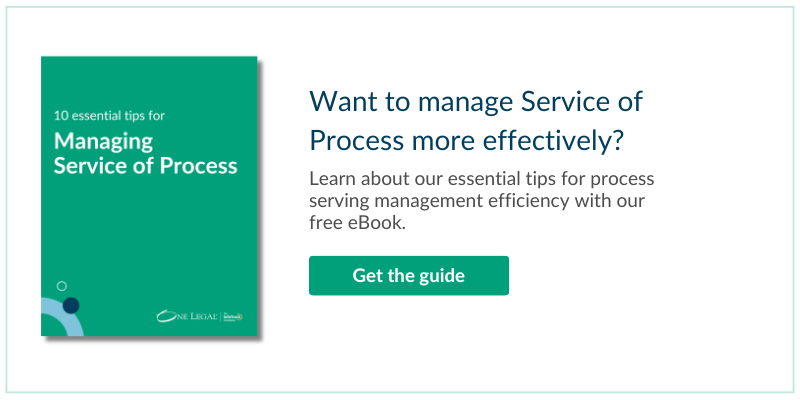A motion to dismiss for insufficient service of process is a killer blow to any litigation proceeding.
So, you’ve filed and served what you believe to be a flawlessly drafted complaint on behalf of your client and now you’re sitting back waiting for the answer to roll in so the litigation can start in earnest.
But that doesn’t happen.
Instead, a few weeks later, as you sit at your desk sipping your morning coffee, your assistant walks in and hands you a stack of papers that is much thicker than any answer you’ve ever seen.
“You’re gonna wanna see this,” he says, as he drops the pile on your desk.
As you read the header of the document, your heart jumps into your throat.
“Defendant’s Motion to Quash for Improper Service of Process.”
What? How can this be?
Your mind races a million miles a minute. Who served this summons and complaint? Did you forget to sign something? Worse yet, will the court dismiss the action? Will your client sue you for malpractice? Instantly, you’re regretting that decision to go to law school instead of veterinary college.
Hold on. Just relax. This may not be as big of a problem as you’ve already made it in your mind.
In this post, we’re going to help you understand this anxiety-producing motion to quash. We’ll begin by giving you a run-down of some of the most common flaws in process serving within California.
From there, we’ll discuss the potential consequences of this motion, and provide you with a game plan for responding.
Understanding service of process in California
Let’s be clear from the outset. Although some attorneys view service of process as an administrative task to be delegated to underlings, the service of process is actually the procedural foundation that the integrity of legal proceedings rests on.
In California, as in other jurisdictions, the law demands strict adherence to specific rules governing how legal documents, particularly complaints and summonses, are delivered to defendants.
These requirements are not simple procedural hoops to jump through; they ensure that a defendant is given proper notice of legal actions against them. And this, of course, is one of the most basic aspects of due process.
Legal requirements for service of process
Under the California Code of Civil Procedure, service of process can be conducted in several ways, including personal service, service by mail accompanied by an acknowledgment of receipt, and substituted service if direct service is not feasible.
Personal service, the gold standard, involves delivering the legal documents directly to the person being sued. Substituted service, allowed only under certain conditions, may involve leaving documents with another individual or at a specific location and subsequently mailing copies to the defendant’s known address.
The law about the mechanics of service is clear: The server must be a non-party to the action, over the age of 18, and comply with all procedural requirements for the chosen method of service.
Detailed records of the service, including the manner, time, and place of service, must be kept; these details are often recorded in a proof of service document filed with the court.
Common pitfalls and errors
Despite these clear guidelines, errors in service of process are not uncommon. In fact, we hear about them all the time when we’re retained to serve papers on subsequent go-arounds.
One typical mistake involves misunderstanding the rules around substituted service, leading to service that the court deems improper due to insufficient attempts at direct service or incorrect follow-up.
Another frequent issue arises from serving the wrong person or serving an individual at a place of business without ensuring the person receiving the documents is authorized to accept service on behalf of the defendant.
In some cases, servers fail to file the proof of service or complete it inaccurately, creating potential for the service to be contested.
It’s also not unheard of for attorneys to choose a method of service not recognized by California law, such as service via email without explicit consent or legal provision, leading to disputes over the validity of the service.
Potential consequences of a motion to dismiss for insufficient service of process
Enough about the mistakes. Let’s get to the meat of the issue – what the heck happens to your client’s case if the motion to dismiss for insufficient service of process is granted? While not necessarily fatal to the underlying action, having your service quashed is definitely something you want to avoid.
Here’s why:
Immediate effects of a granted motion
The most immediate consequence of a motion to quash being granted is typically the nullification of the original service. This effectively pauses the current legal proceedings until proper service can be established. That’s right – the court does not typically dismiss the case with prejudice after one improper service.
As explained by one California Appellate Court:
An order vacating service of summons and dismissing an action puts an end to litigation without a judicial investigation of the merits; and the effect of granting a motion to quash service is to declare the service void and not to dismiss the complaint. On the writ being quashed, the case stands as if no writ had been issued.
That’s pretty good news if you’re the plaintiff’s attorney, right? Sure, but what this does mean for you, however, is a return to square one in terms of serving the defendant. To add insult to injury, this second bite at the apple often comes under the pressure of statutory time limits that can complicate or even jeopardize the case.
Furthermore, a successful motion to quash can lead to a court order mandating the payment of the defendant’s attorney fees in some circumstances. This not only increases the financial burden on your client but can also strain the attorney-client relationship, especially if the mistake was avoidable.
Long-term implications
Beyond these immediate effects, the granting of a motion to quash can have long-term implications for the overall case – and your career.
For example, delaying the litigation process can disadvantage your client strategically by giving the defendant more time to prepare or counteract your legal strategy. This can alter the balance of power in negotiations and lead to less favorable settlement terms.
Additionally, repeated failures in process serving can undermine a lawyer’s relationship with clients. This can be especially harmful if you’re a new lawyer looking to build your practice through referrals and reputation.
Common service errors
Motion to dismiss for insufficient service of process is a frequent and undesirable outcome.
For instance, one frequent error is attempting to serve a corporation by delivering documents to an employee without proper authorization.
In such cases, documents are often mistakenly given to a receptionist or junior staff member who lacks authority to accept service on behalf of the organization.
This can result in service being invalidated, leading to delays and potentially jeopardizing statutory deadlines.
Another common error involves substituted service — where documents are left with another adult at the defendant’s residence or workplace, followed by mailing copies.
If insufficient attempts are made to serve the defendant directly or if documents are left with someone who cannot be verified as living at the residence (such as a visiting friend or contractor), courts may deem the service improper.
Additionally, errors arise when service is completed in a method not legally permitted, such as serving documents via email without prior court approval or the defendant’s explicit consent.
Such mistakes can open up grounds for the defendant to file a motion to quash, resulting in costly delays.
A step-by-step guide for responding to a motion to quash
No matter how frustrated you are with this motion to dismiss for insufficient service of process, it’s vital that you respond strategically and efficiently. Here’s how:
Step 1: Assess the validity of the motion
Begin by reviewing the defendant’s motion thoroughly. Understand the specific grounds cited for the motion to quash. Be sure to evaluate the evidence presented by the defendant and cross-reference with your own documentation and proof of service. This initial assessment will help you determine whether the motion is valid.
Step 2: Consult with Your Client
This is going to be awkward at best but you have to discuss the situation with your client, including an explanation of the potential impacts and your proposed response. Make sure the client understands the possible outcomes and associated costs of defending against the motion or re-serving the documents. (And if this was purely your fault or the firm’s fault, consider covering those costs).
Step 3: Prepare your response
If you decide to contest the motion to quash, prepare a response that addresses each point raised by the defendant. Include:
- A factual recount of how service was attempted or completed.
- Any legal arguments that support the validity of the service. Reference statutes, case law, and court rules that justify the service method used.
- Attachments or evidence that corroborate your position, such as declarations from the process server or photographic evidence of service.
Step 4: Consider negotiating with opposing counsel
Sometimes, it may be strategically advantageous to discuss the issue with the opposing counsel before the motion is heard in court. This can lead to an agreement that resolves the service issue without further court intervention, such as agreeing to accept service if certain conditions are met. That might save time and legal fees for both parties – and save face for you with the client and the court.
Step 5: Prepare for the hearing
If you have to file an opposition to the Motion, do so and then thoroughly prepare to argue your case at the hearing. If you still believe service was valid, be prepared to defend it. If not, consider being prepared with strategies to present to the court for how proper service can be effected.
Step 6: Plan for re-service, if necessary
If the court grants the motion to quash, immediately plan for re-serving the documents correctly. Review the court’s feedback and ensure all errors are addressed. We’d also be remiss if we didn’t suggest that you use a reputable process server this time around.
By following these steps, you can effectively respond to a motion to quash, minimize its impact on your case, and safeguard your professional reputation. This proactive approach not only addresses the immediate issue but also strengthens your practice for future challenges.
Of course, as with any negative consequence in the law, prevention is the best cure. If you’ve been relying on unprofessional process servers, perhaps it’s time to step up your game by utilizing available technology and reliable pros.
Conclusion
In the world of legal proceedings, a seemingly flawless complaint can quickly unravel with a motion to dismiss for improper service of process. As anxiety mounts and worst-case scenarios flood the mind, it’s crucial to confront the issue strategically and decisively.
Understanding the intricacies of service of process in California lays the groundwork for effective response. From personal service to substituted methods, adherence to strict procedural guidelines is paramount. Yet, common pitfalls abound, from errors in service type to incomplete documentation.
The consequences of a motion to quash extend beyond immediate setbacks, potentially derailing litigation and straining client relationships. However, a methodical approach to response, including assessment, client consultation, and strategic negotiation, offers a path forward.
Ultimately, proactive measures, such as leveraging technology and reliable process servers, can mitigate risks and fortify professional integrity. By embracing diligence and foresight, attorneys can navigate challenges, uphold due process, and safeguard the interests of their clients.








